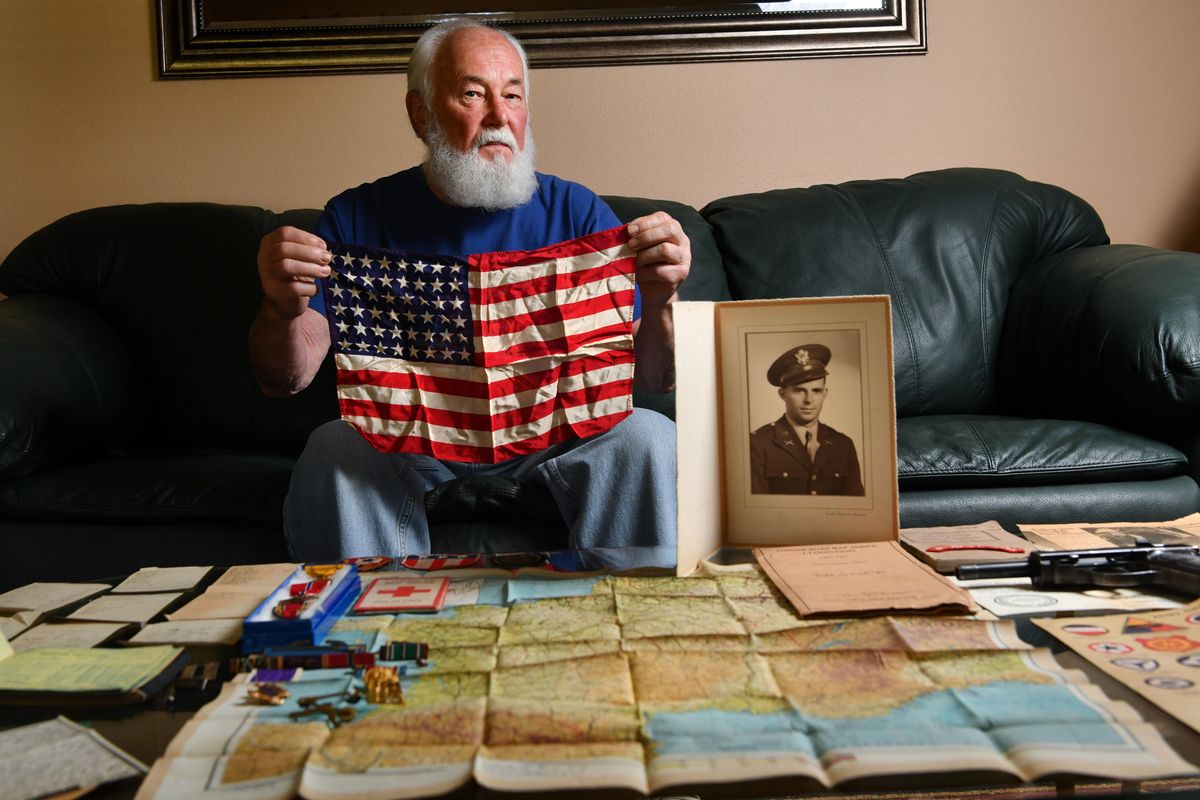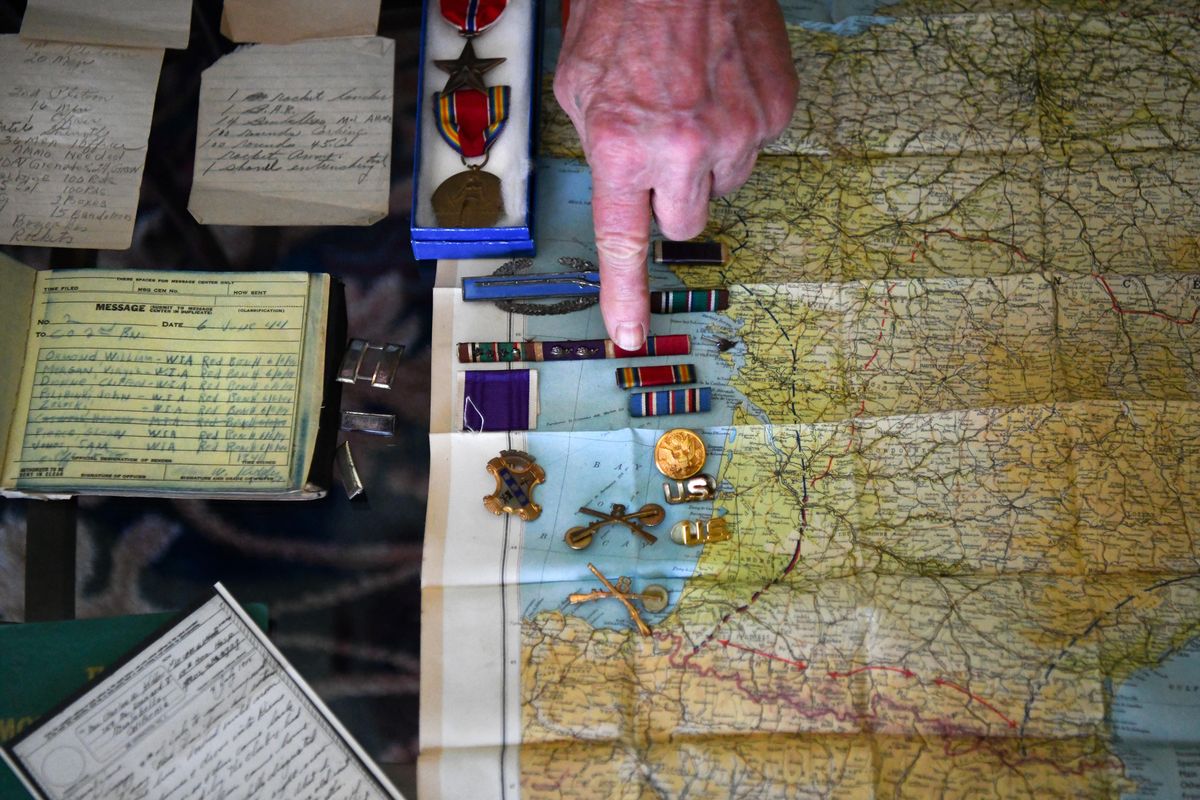Ensuring memories of war are preserved: Spokane Valley resident aims to honor those who served
Army history buff Jon Franklin poses for a photo with a collection of World War II memorabilia brought back from D-Day by 1st Lt. Charles Kidder, Company G, 2nd Battalion, 8th Infantry Division on Thursday, June 13, 2019, at his home in Spokane Valley, Wash. (Tyler Tjomsland / The Spokesman-Review)Buy a print of this photo
Jon Franklin never met Charles Kidder. But he feels like he knows him. Knows the horror he experienced on D-Day. Knows his longing for the wife he’d left behind. Knows the courage it took for him to do his job: filling out the morning report; cataloging the men who were killed, wounded or missing.
Several years ago, Kidder’s nephew gave Franklin a box filled with his uncle’s military souvenirs. The nephew was a good friend of Franklin, and knew he’d appreciate the treasures no one else in the family wanted.
Mementos included Kidder’s Purple Heart with two oak leaf clusters, indicating he’d been wounded three times, his Bronze Star and V-mail he sent to his wife. It also contained the carbon copies of Kidder’s morning report book and handwritten notes from squad leaders listing the dead, wounded and missing, along with ammunition and weapon counts.
“The first thing I saw was the morning report from D-Day,” Franklin said.
The report begins June 6, 1944, and continues to June 14, when Kidder was wounded.
Franklin, 78, has amassed an impressive collection of military memorabilia at his home in Spokane Valley.
“It all started in grade school,” he said. “I still have my collection of war stamps. Adults bought war bonds; kids bought stamps – a dime per stamp.”
He was born six months before the attack on Pearl Harbor, but has vivid memories of the patriotic spirit that flooded the nation.
“At school every Monday, we’d march around the building to John Philip Sousa marches,” he recalled.
Franklin served in the Army from 1959-’62.
“I turned 18 on May 12 and on May 19; I was on the train for boot camp.”
Though he had his war savings stamps, his collection took off with a German army helmet given to him by a neighbor in California, where he lived before moving to Spokane in 1979.
“My neighbor served in World War II and was moving,” Franklin said. “He asked me if I wanted the helmet.”
He did, and he also received a German arm band and and a small flag.
“I was hooked,” he said.
Franklin has found many items in his collection at garage sales, including a tiny gold star lapel pin.
“It’s smaller than a dime, but it’s bigger than life,” he said.
The gold star lapel pin was presented to parents and other next of kin of those who were killed in combat.
Items in Franklin’s collection range from a large photograph of the officer staff from the Washington contingent of the United States Volunteers from the Philippine-American War in 1899, to the uniform his son wore when he served during the Persian Gulf War.
He has leather leggings worn by cavalry soldiers during World War I, and collection of photographs of men who served during that war.
It saddens him to find these treasures abandoned at garage sales.
But it’s the box of items from 1st Lt. Charles Kidder that he feels most connected to.
“He came right out of OCS (officer candidate school) and went straight to D-Day,” Franklin said.
Kidder, 30, was the executive officer of Company G, 2nd Battalion, 8th Infantry Army Division.
“I had the same job, in the same Division,” Franklin said. “I did the morning report on a typewriter in an office, but Charlie had to do that on a beach with a pencil and carbon paper, while people were shooting at him, and he had to worry about how many people died while he was making the report.”
Franklin has notes written on scraps of paper that squad leaders delivered to Kidder who then compiled the information in his report.
Kidder’s first entry, dated 6 June ’44, begins, “Walters Robert Killed in Action, Red Beach.”
An entry from June 11 reads:
“Pfc John McGeehan KIA 11 June 44
Pfc Herman Caswell WIA 11 June 44
Pfc Richard Holmes WIA 11 June 44
48 men (strength)”
A V-mail Kidder sent his wife while recuperating from his third injury is dated July 4, 1945, and underscores his longing for home.
“I’m sure I’ll be home for Xmas,” he wrote. “If not I’ll swim home. Please pray that we’ll be together soon.”
He also wrote, “This growing old isn’t any fun.”
Kidder was 31 at the time.
Knowing the importance of his collection, Franklin plans to donate it to the National Museum of the U.S. Army which is being built in Washington, D.C.
Franklin is one of the museum’s founding sponsors.
His motive in collecting and preserving these bits and pieces of history is simple, but profound.
“I want to honor the greatness of the people who served and died for this country,” he said.

